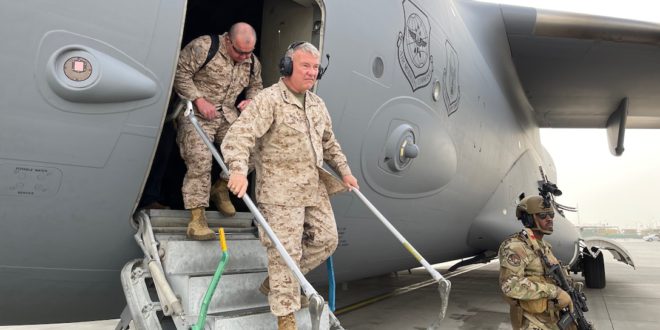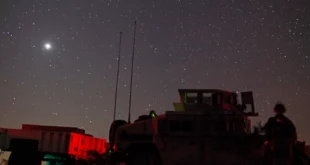Afghanistan: Posture Statement of General Kenneth F. McKenzie, Jr. commander, CENTCOM before the Senate Armed Services Committee March 15, 2022
ISIS-Khorasan (ISIS-K) poses a moderate to high threat to the Taliban and civilians in Afghanistan, and this threat has the potential to grow in the coming months and years. As the economic situation and humanitarian crisis in Afghanistan worsen, with food security continuing to deteriorate, vulnerable populations will potentially become increasingly susceptible to ISIS-K recruitment. ISIS-K continues targeting the Taliban, Shia populations, urban centers, and targets of opportunity and is attempting to expand from its historic eastern Afghanistan operating areas, as evidenced by its claims of high-profile attacks from Kunduz in the north to Kandahar in the south. ISIS-K likely will remain capable of conducting high-profile attacks throughout Afghanistan, seeking to increase recruitment, expand its operating area, and challenge the Taliban’s control.
Absent sustained CT pressure, ISIS-K may gain strength and be emboldened to expand its operations and target neighboring countries—as evidenced by recent attacks against Shia civilians in Pakistan. The Department of Defense assesses ISIS-K could establish an external attack capability against the United States and our allies in twelve to eighteen months, but possibly sooner if the group experiences unanticipated gains in Afghanistan.
In the near-term, AQ will most likely continue to maintain a low-profile under pressure from the Taliban, which seeks international legitimacy. Given its long-standing ties with the Taliban and Haqqani Network, CENTCOM assesses some AQ elements have limited freedom of movement in Afghanistan.
AQ likely still aspires to recruit and train, and if successful, restore an external attack capability against the United States and our allies in twelve to twenty-four months. Following the August 2021 Taliban takeover of Kabul, on-the-ground CT efforts against Afghanistan-based VEOs fell largely to the Taliban.
Since taking Kabul, the Taliban have prioritized internal security and begun taking steps to combat ISIS-K’s ability to attack the regime in the near-term, and to reconstitute in the long-term. As 2022 unfolds, the Taliban’s so called “Ministry of Interior” (MOI) and “General Directorate of Intelligence” (GDI) likely will synchronize efforts to combat ISIS-K’s urban attack cells, while focusing on developing intelligence networks to weaken ISIS-K’s historic support zones in eastern Afghanistan. The Taliban’s restraints and actions against other regional VEOs have been markedly less aggressive.
For the United States, conducting CT operations in Afghanistan from “over the horizon” remains difficult, but not impossible. The loss of collection following the withdrawal of U.S. forces has exacerbated gaps in our intelligence. This limits the intelligence community’s ability to provide indications and warning of VEO threats from Afghanistan. Also limited is the United States’ ability to fix and finish those threats we are able to find. The resultant reductions in consistent CT pressure potentially could enable VEO groups to pose increased threats to the United States and our allies, assuming the Taliban is unwilling or unable to do so itself. Presently, CENTCOM relies on the Operation ENDURING SENTINEL Over-the-Horizon Counter Terrorism (OTH-CT) Task Force and a finite number of UAS sorties to develop and potentially strike terrorist targets in Afghanistan.
Additional opportunities for enhanced cooperation present themselves among the Central Asian States and Pakistan. Due to pressure from Russia (and, to a lesser extent, China), membership in its Collective Security Treaty Organization, and varied willingness to engage with the new Taliban government, the Central Asian States are measured in their support for counterterrorism cooperation in Afghanistan. Nevertheless, they remain concerned about the risk of extremist spillover from Afghanistan and will likely seek out a limited and measured expansion in U.S. security cooperation engagements while continuing to strike a balance in regional dynamics with all partners.
Already, partners in Central Asia value several U.S. security cooperation activities, including support for border security activities, basic peacekeeping skills development, and Foreign Military Sales/Foreign Military Financing. Moreover, Tajikistan, Uzbekistan, and Turkmenistan, which all border Afghanistan, hold military exercises and receive training from U.S. advisors. Working across the whole-of-government with our interagency partners, as well as international partners and allies, to mitigate the growing humanitarian and economic crises will also be a critical component of effectively countering the growth of VEOs in Afghanistan.
Islamic State Growing in Afghanistan But Not Ready to Attack US, West. VOA Jeff Seldin weighs in
More than six months after the U.S. pulled its last troops from Afghanistan, the threat from the Islamic State’s Afghan affiliate is growing, though new intelligence assessments suggest that earlier warnings the group might be able to strike at America and its allies as early as next month appear to have been overblown.
Various intelligence estimates from the U.S. and other countries warn that the group, known as IS-Khorasan and ISIS-K, nearly doubled in size to more than 4,000 fighters during the Taliban takeover of Afghanistan last year. The commander of U.S. forces in the Middle East and South Asia said Tuesday that without sustained pressure from the U.S. and U.S.-backed Afghan forces, the IS affiliate is solidifying its foothold.
“We are concerned about the developmental trajectory of ISIS-K,” U.S. Central Command’s General Kenneth “Frank” McKenzie told U.S. lawmakers.
“We continue to watch carefully as ISIS grows,” he said. “ISIS has been able to execute some high-profile attacks even in Kabul over the last several months. … It is my expectation that ISIS attacks will ramp up as we go into the summer.”
But while IS-Khorasan remains dangerous, the group has not advanced its capabilities as quickly as some U.S. officials initially feared.
The Pentagon’s third-highest ranking official warned lawmakers in October that it appeared the group would be able to regenerate the capabilities needed to launch terror attacks on the West in as little as six months.SEE ALSO:Timeline for Potential Attacks by Islamic State, Al-Qaida Getting Shorter
Since then, however, it appears IS-Khorasan under the leadership of Shahab al-Muhajir, also known as Sanaullah Ghafari, has focused more on its fortunes in Afghanistan.
Intelligence shared by United Nations member states indicates the group prioritized retaking territory and now controls some limited areas in eastern Afghanistan. Western intelligence officials and humanitarian groups have seen signs IS-Khorasan is laying the groundwork for expanding its networks among Afghanistan’s neighbors.SEE ALSO:Al-Qaida, IS Set to Reconstitute in Afghanistan, Beyond
Perhaps as a result, the threat of an attack by IS-Khorasan in the West has somewhat diminished, at least for the moment.
The best U.S. intelligence estimates now indicate the soonest IS-Khorasan could launch terror attacks in the West is 12 to 18 months, McKenzie told lawmakers, cautioning the timeline could change depending on developments on the ground, where clashes with the ruling Taliban persist.
“[IS-Khorasan] still aspire to attack the United States and our partners abroad,” McKenzie said. “The Taliban are attempting to maintain pressure. … They’re finding it difficult to do.”
The U.S. is having its own problems tracking IS-Khorasan, as well as rival terror group, al-Qaida, limited largely to flying reconnaissance flights from neighboring Pakistan now that it no longer has troops on the ground in Afghanistan.
“It is much harder to do it now than it was before,” McKenzie told lawmakers, though he added, “It is not impossible.”
“We will be able to do this only so long as CENTCOM has the requisite resources to find, fix and finish threats to the homeland before those threats develop the capability to conduct external operations,” he said. “CENTCOM has the tools it needs to perform this mission, but the margins are thin, and the risk will increase should resources diminish.”
The CENTCOM commander also told lawmakers that the U.S. has not carried out any counterterrorism strikes in Afghanistan since the U.S. withdrawal from the country was completed.
Syria and Iraq
In contrast to Afghanistan, U.S. efforts to contain IS in Syria and Iraq are faring better, McKenzie said.
“In the Euphrates River Valley in Iraq and Syria, ISIS is unable to think beyond surviving that night or the next night,” he told lawmakers, crediting sustained pressure from Iraqi forces and the U.S.-backed Syrian Democratic Forces.
But in Syria, concerns persist about the large, displaced persons camps, including al-Hol, which hold thousands of people, including the families of IS fighters.
The camps, McKenzie said, present IS with “fertile soil for indoctrination and spreading terror.”
 Soldier of Fortune Magazine The Journal of Professional Adventurers
Soldier of Fortune Magazine The Journal of Professional Adventurers






